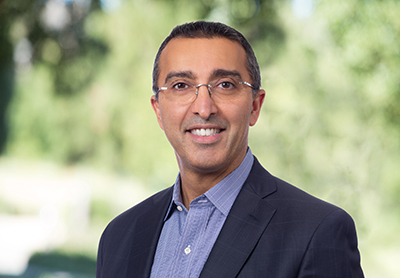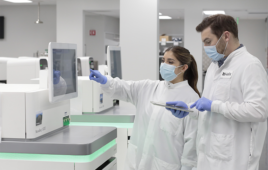
Seer logo
Founded in 2017, the proteomics company Seer (Nasdaq:SEER) is building up a growing roster of customers, including pharma and biotech companies, translational and academic labs and CROs. Applications of its technology include biomarker discovery, target identification and multiomics research for cancer or other complex disease detection.
Recently, Weill Cornell Medicine and privately-held SpaceX used Seer’s proteome profiling technology to identify 50 differentially abundant proteins in astronauts postflight. In all, 22 proteins were upregulated, and 28 were downregulated across six time points collected before, during and after the flight. The proteins were “differentially changed as a function of a flight,” said Seer CEO Omid Farokhzad in a recent interview. The research could lead to a better understanding of the impact of space travel on people.
Another Seer customer, Evotec (Nasdaq:EVO), used Seer technology to analyze 105 samples from patients with chronic kidney disease. The research demonstrated ultra-high coverage of more than 5,000 proteins across samples (3,000 average per sample). Evotec’s study also observed a significant expansion of cytokines of at least 30% compared to depletion protocols. In addition, proteins were quantified at 3–5 fold higher levels than depleted and un-depleted serum. This data supports a comprehensive serum proteomics workflow that can be used for patient stratification and the potential identification of novel biomarkers.
[This feature is a part of 2022’s Pharma 50 series.]
The SpaceX and Evotec results were presented at the recent American Society for Mass Spectrometry (ASMS) conference in June 2022 in Minneapolis.
In a recent interview, Farokhzad explains why he founded Seer and where he sees the company heading in the future.
The responses have been lightly edited.
Drug Discovery & Development (DDD): Can you briefly describe your career and how it led you to found Seer?

Omid Farokhzad, CEO of Seer
Omid Farokhzad: I trained as a molecular biologist at Massachusetts General Hospital (MGH) before finishing my medical degree. After I finished, I did a postdoc with Professor Robert Langer’s chemical engineering group at MIT. Bob runs a multidisciplinary lab, so it wasn’t unusual for a physician to join the lab. As an engineer, Bob did his postdoc at Dr. Judah Folkman’s lab. Dr. Folkman was a cancer biologist at Harvard Medical School. So Bob was used to working with physicians.
It was wonderful to train orthogonally. There were a different set of languages, if you will, that I learned during that period. And then, I joined the Harvard Medical School faculty in 2004, where I had done my clinical training. I started a lab there dedicated to nanomedicine. If you went back in time and did a PubMed search with the term “nanomedicine” in 2004, about a dozen papers were published on the subject.
Fast forward a decade later, we started a center called the Center for Nanomedicine at Brigham and Women’s Hospital — a teaching hospital at HMS. Today, virtually every major medical center has a nanomedicine department, institute or center. And its impact has been broad across all dimensions of medicine, including therapeutics, diagnostics and discovery.
Seer was the fifth company that came out of our academic lab.
When I started the nanomedicine lab in 2004, I was primarily a scientist. I did little clinical work early on and no clinical work toward the latter part of my academic career.
When I was developing nanoparticle technologies for medical applications, the lion’s share of our work was on the therapeutic side. When you develop nanoparticles for therapeutic applications, typically, the particle is a carrier. The surface of the particle is engineered for an application such as targeting cancer or immune cells.
Some of our earliest work was to develop a targeted nanoparticle to treat cancer. We brought the first example of a controlled-release nanoparticle that could target cancer into clinical trials. Later we used nanoparticles for immune activation and immune tolerance. Now we have examples of that in clinical trials.
Much of that work was to make nanoparticles functional in a biological system. We spent a ton of time designing nanoparticles to do what you want them to do outside of the body. But the moment they hit a biological system, the nanoparticle’s surface would bind to the macromolecules that are present in a biological system. If it was an injectable drug, what’s present in blood or plasma binds would bind to the particle’s surface. We called that ‘biofouling’ because we didn’t like what was happening.
There was a lot of effort, pre-dating my training, to create non-biofouling surfaces for various medical applications.
It turned out that what we considered fouling was inaccurate. About 15 years ago, a group in Dublin published an important paper showing that the binding of biological components to the surface of a nanoparticle is precisely driven by that particle’s physicochemical nature. It is highly reproducible. They coined the term ‘protein corona’ to refer to the proteins on the particle’s surface.
Since then, many papers have been published in this area. My lab also looked at ways to engineer surfaces for a desired biological outcome, which meant a desired biological binding or non-binding. Then, there was a moment when a light bulb went off in our heads. By designing particles with distinct physicochemical properties, we can sample the proteome uniquely. That was the premise for starting Seer — that we would essentially capitalize on what we had first considered as a problem for us in the therapeutic space.
Given the advances that have been made in genomics over the past 15 to 20 years, proteomic advances are only in their infancy.
DDD: So, in software speak, you transformed biofouling from being a bug and made it into a feature?
Farokhzad: Exactly right. My software team has used that line in talks that they give.
DDD: On a related note, could you talk about the Proteograph Product Suite that came out recently?
Farokhzad: SEER enables the scientific community to see the proteome with depth and breadth in ways that weren’t possible before. The Proteograph Product Suite is the product that does that. It comprises our proprietary nanoparticles, consumables, automation instrument, and a software package called the Proteograph Analysis Suite. This software translates biological data to biological insight with intuitive visual interfaces for users to take advantage of whatever application they’re after. What the customer provides is a mass spectrometer, something that many labs have. There are about 50,000 mass specs installed globally, and about 15,000 do proteomics work today.
DDD: What are Seer’s short-term and long-term goals, and what does it mean for the industry if you meet them?
Farokhzad: Our short-term goal is to continue enabling the scientific community to access proteomic content at a speed and scale that previously was not possible. When you do that, everyone benefits – we believe an ecosystem will be created. The detector providers benefit, and so do the software providers. Novel proteomic content discovery will enable the creation of entirely new markets or expand existing markets.
For an example of how this could materialize, genomic content made it possible to do a liquid biopsy and early cancer detection. Those areas will be enhanced by the addition of novel proteomic content. As the access to the proteome increases, value increases and utility expands. This type of novel content will enable increased biological insight that wasn’t possible with access solely to the genome.
We’re already seeing this play out. We have partnered with leading mass spec companies like Bruker, Thermo Fisher and Sciex because they saw that our technology could enable a set of customers that are not their normal customers. For example, a genomic customer who wants to determine the functional relevance of their genomic content. Mass spec providers have an opportunity to tap into new markets that previously did not have access to proteomic data in this way, and as a result, will now be able to add proteomic data to their genomic data. The community is already asking us if we can integrate proteomic information with genomic information more readily. Our team is working to enable proteogenomic analysis once the data comes out.
I’m excited about our product roadmap. The product we launched is already having an enormous impact on our customers, and we’re beginning to see their presentations at scientific conferences.
We’re also developing follow-on products that can make the customer access to proteomic information faster, deeper or with even more sample efficiency. So I think that the future is very bright. We’re literally at the very, very beginning of this trip.
The analogy I would make is that today the scientific community has sequenced over a million genomes and over 10 million exomes. That is 15-plus years after next-generation sequencing was introduced. The first genome took 15 years and $2.7 billion to sequence. But now, we’re sequencing about 48 genomes in two days at around $1,000 per genome. That is an enormous amount of content.
We’re at the very, very beginning of this in terms of proteomic content generation. So I think 15 years from now, there’ll be a massive amount of content and insight that will emerge because of large-scale access to proteomic information. Seer is making that possible.
Filed Under: Drug Discovery and Development, Genomics/Proteomics, Video features





Tell Us What You Think!
You must be logged in to post a comment.